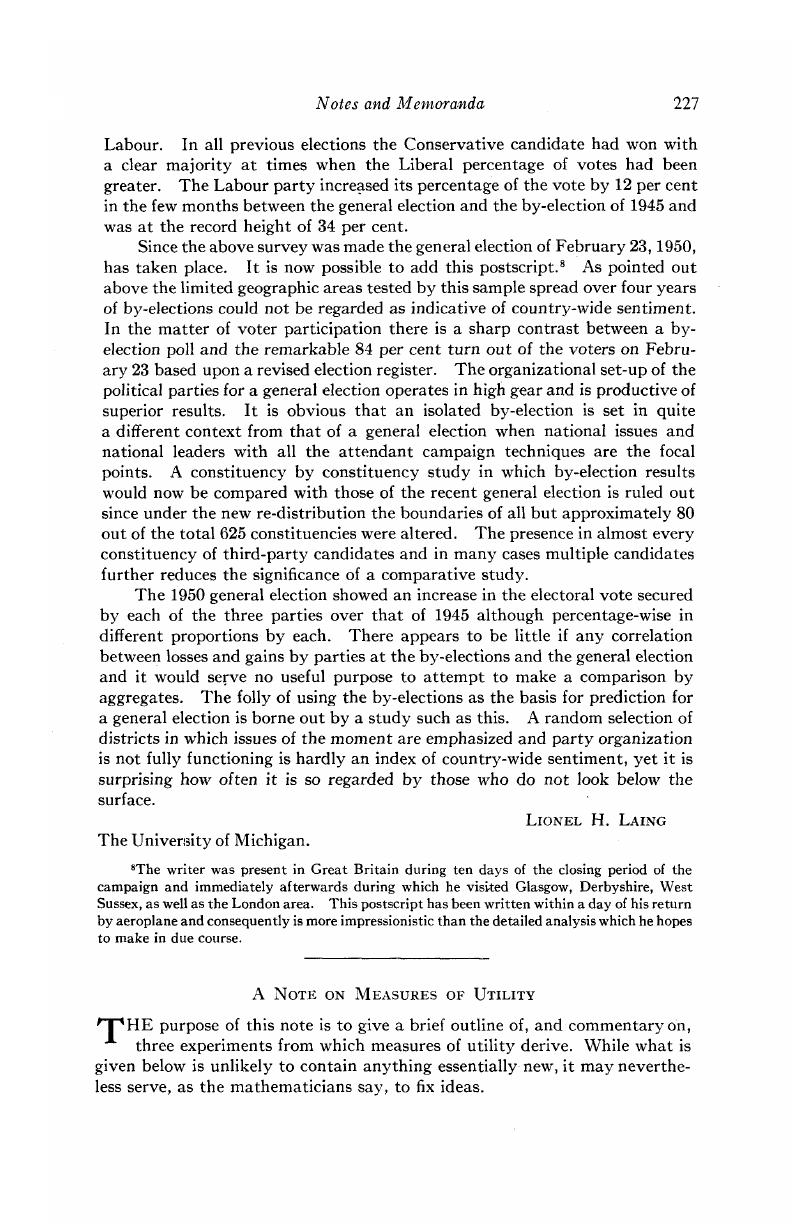Published online by Cambridge University Press: 07 November 2014

1 It will be observed that the experiment has been interpreted in terms of wants or desires rather than satisfactions or pleasures. This is conservative and seems sufficient.
2 These conditions (and the similar conditions in later sections) contain a redundancy. They are, however, in a form useful for discussion.
3 If B′ should be $4,001 say, the outcome indicates a law of diminishing marginal utility for dollars, at any rate for increments of $4,000 ($10,000 is preferred to $8,001).
4 Any two triplets, say a′, b′, c′ and a″, b″, c″, satisfying the conditions cited must be related in this fashion: i″ = m + ni″, where i = a, b, c, m is a constant, and n is a positive constant.
5 He may later be asked to compare other adjacent preferences, but this extension to the experiment serves only to test consistency in the subject’s responses, that is, to discover whether his responses are rational in the sense used earlier. The point is discussed below.
6 More precisely, if the scale ranges from a to c, then sub-divisions b″ and b′ (which correspond to events B″ and B′, B″ being preferred to B, and B to B′) can be found such that b″ − b′ / a − c < k, where k is an arbitrarily small positive number. The inequality is not affected by transformation of the scale.
7 This is intended to signify no more than that Jevons assumed that preferences could be directly compared, thereby adopting a common-sense attitude to the problem that has not always been shared.
8 A comment or two may be made in passing. In welfare economics the assumptions that need be made are brought one step closer to the testable if cardinal utility is admitted. In the methods developed in the Theory of Games and Economic Behaviour of J. Von Neumann and O. Morgenstern, a cardinal utility is at present part of the requirements. Even in works similar to J. R. Hick’s Value and Capital, the argument would be simplified and at times more plausible if cardinal measures were available. In this connexion consider marginal rate of substitution and complementarity.
9 The construction of the cardinal experiment in the paragraphs above was such that inconsistencies were encountered only after the experiment proper was over—see footnote 5. The ordinal experiment can be constructed in a similar way. Thus, the subject is first asked to compare A and B, then the preferred of A and B, say A, and C. If C is preferred, the experiment proper is over, and the outcome is C is preferred to A, and A to B. Inconsistency may then arise if the subject is asked to compare C to B. B preferred to C is the irrational outcome mentioned earlier.
10 This, if one interprets their text correctly, is part of the experiment proposed by J. Von Neumann and O. Morgenstern in their Theory of Games and Economic Behaviour. See the early sections of that text.
11 The original events can be of the same form as the auxiliary event, that is, can be certainties composed of mutually exclusive probabilities. (None of this conflicts with the earlier definition of A, B, C, etc. as hypothetical future events.) As an interesting example, suppose that A is one chance in a hundred of $100, B is a certainty of $1, and C is one chance in two of $2, and that the subject prefers A to B and to C, and B to C. Or again, suppose that A is one chance in two of $1, B, three chances in eight of $1, and C, one chance in four of $1, and that the subject, rationally enough, prefers A to B and to C, and B to C, and yet fixes p′ at 1/3. The outcome indicates bad arithmetic, not irrationality.
12 That the summary is plausible is seen in this: if the subject greatly prefers A to B, and is almost indifferent as between B and C, p′ is likely to be small, and a − b will be large in relation to b − c, as it should be.
13 There is no difficulty in constructing extensions to the simple ordinal experiment which require for a numeiical summary a cardinal scale. In this sense there are indefinitely many cardinal measures of utility. As argued above, however, if the Jevonsian experiment fails, the alternative experiments are of little interest.
Analogous experiments to the three utility experiments described above can be readily constructed. For example, if we were interested in temperature only as it is perceived by the individual, we might confront our subject with pans of water at various temperatures. Construction of the analogues to the ordinal and Jevonsian experiments is obvious. The analogue to the expectations experiment can be obtained by mixing in noted proportions water at the highest with water at the lowest of the temperatures. Even here, while the scale obtained by the third procedure would probably be closer to the usual “objective” scale than that obtained by the Jevonsian procedure, it would not be as satisfactory for the purpose in hand. Notice that the remarks about inconsistency, and for that matter, the commentary in general, apply to such analogues.